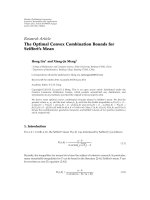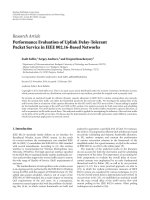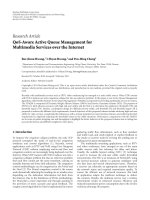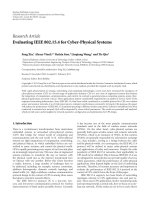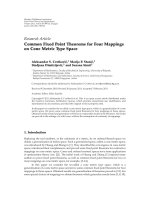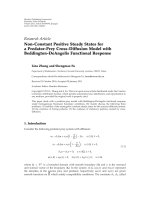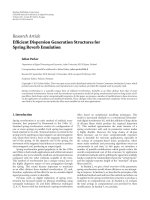Báo cáo hóa học: " Research Article Common Coupled Fixed Point Theorems for Contractive Mappings in Fuzzy Metric Spaces" potx
Bạn đang xem bản rút gọn của tài liệu. Xem và tải ngay bản đầy đủ của tài liệu tại đây (514.77 KB, 14 trang )
Hindawi Publishing Corporation
Fixed Point Theory and Applications
Volume 2011, Article ID 363716, 14 pages
doi:10.1155/2011/363716
Research Article
Common Coupled Fixed Point Theorems for
Contractive Mappings in Fuzzy Metric Spaces
Xin-Qi Hu
School of Mathematics and Statistics, Wuhan University, Wuhan 430072, China
Correspondence should be addressed to Xin-Qi Hu,
Received 23 November 2010; Accepted 27 January 2011
Academic Editor: Ljubomir B. Ciric
Copyright q 2011 Xin-Qi Hu. This is an open access article distributed under the Creative
Commons Attribution License, which permits unrestricted use, distribution, and reproduction in
any medium, provided the original work is properly cited.
We prove a common fixed point theorem for mappings under φ-contractive conditions in fuzzy
metric spaces. We also give an example to illustrate the theorem. The result is a genuine
generalization of the corresponding result of S.Sedghi et al. 2010
1. Introduction
Since Zadeh 1 introduced the concept of fuzzy sets, many authors have extensively
developed the theory of fuzzy sets and applications. George and Veeramani 2, 3 gave
the concept of fuzzy metric space and defined a Hausdorff topology on this fuzzy metric
space which have very important applications in quantum particle physics particularly in
connection with both string and E-infinity theory.
Bhaskar and Lakshmikantham 4, Lakshmikantham and
´
Ciri
´
c 5 discussed the
mixed monotone mappings and gave some coupled fixed point theorems which can be used
to discuss the existence and uniqueness of solution for a periodic boundary value problem.
Sedghi et al. 6 gave a coupled fixed point theorem for contractions in fuzzy metric spaces,
and Fang 7 gave some common fixed point theorems under φ-contractions for compatible
and weakly compatible mappings in Menger probabilistic metric spaces. Many authors 8–
23 have proved fixed point theorems in intuitionistic fuzzy metric spaces or probabilistic
metric spaces.
In this paper, using similar proof as in 7, we give a new common fixed point theorem
under weaker conditions than in 6 and give an example which shows that the result is a
genuine generalization of the corresponding result in 6.
2 Fixed Point Theory and Applications
2. Preliminaries
First we give some definitions.
Definition 1 see 2.Abinaryoperation∗ : 0, 1 × 0, 1 → 0, 1 is continuous t-norm if ∗
is satisfying the following conditions:
1 ∗ is commutative and associative;
2 ∗ is continuous;
3 a ∗ 1 a for all a ∈ 0, 1;
4 a ∗ b ≤ c ∗ d whenever a ≤ c and b ≤ d for all a, b, c, d ∈ 0, 1.
Definition 2 see 24.Letsup
0<t<1
Δt, t1. A t-norm Δ is said to be of H-type if the family
of functions {Δ
m
t}
∞
m1
is equicontinuous at t 1, where
Δ
1
t
tΔt, Δ
m1
t
tΔ
Δ
m
t
,m 1, 2, , t∈
0, 1
.
2.1
The t-norm Δ
M
min is an example of t-norm of H-type, but there are some other
t-norms Δ of H-type 24.
Obviously, Δ is a H-type t norm if and only if for any λ ∈ 0, 1,thereexistsδλ ∈ 0, 1
such that Δ
m
t > 1 − λ for all m ∈ ,whent>1 − δ.
Definition 3 see 2.A3-tupleX, M, ∗ is said to be a fuzzy metric space if X is an arbitrary
nonempty set, ∗ is a continuous t-norm, and M is a fuzzy set on X
2
× 0, ∞ satisfying the
following conditions, for each x, y, z ∈ X and t, s > 0:
FM-1 Mx, y, t > 0;
FM-2 Mx, y, t1 if and only if x y;
FM-3 Mx, y, tMy, x, t;
FM-4 Mx, y, t ∗ My, z, s ≤ Mx, z, t s;
FM-5 Mx, y, · : 0, ∞ → 0, 1 is continuous.
Let X, M, ∗ be a fuzzy metric space. For t>0, the open ball Bx, r, t
with a center
x ∈ X and a radius 0 <r<1isdefinedby
B
x, r, t
y ∈ X : M
x, y, t
> 1 − r
. 2.2
AsubsetA ⊂ X is called open if , for each x ∈ A,thereexistt>0and0<r<1suchthat
Bx, r, t ⊂ A.Letτ denote the family of all open subsets of X.Thenτ is called the topology
on X induced by the fuzzy metric M. This topology is Hausdorff and first countable.
Example 1. Let X, d be a metric space. Define t-norm a ∗b ab and for all x, y ∈ X and t>0,
Mx, y, tt/t dx, y.ThenX, M, ∗ is a fuzzy metric space. We call this fuzzy metric
M induced by the metric d the standard fuzzy metric.
Fixed Point Theory and Applications 3
Definition 4 see 2.LetX, M, ∗ be a fuzzy metric space, then
1 asequence{x
n
} in X is said to be convergent to x denoted by lim
n →∞
x
n
x if
lim
n →∞
M
x
n
,x,t
1,
2.3
for all t>0;
2 asequence{x
n
} in X is said to be a Cauchy sequence if for any ε>0, there exists
n
0
∈ ,suchthat
M
x
n
,x
m
,t
> 1 − ε, 2.4
for all t>0andn,m≥ n
0
;
3 a fuzzy metric space X, M, ∗ is sa id to be complete if and only if every Cauchy
sequence in X is convergent.
Remark 1 see 25. 1 For all x, y ∈ X, Mx, y, · is nondecreasing.
2 It is easy to prove that if x
n
→ x, y
n
→ y, t
n
→ t,then
lim
n →∞
M
x
n
,y
n
,t
n
M
x, y, t
.
2.5
3 In a fuzzy metric space X, M, ∗, whenever Mx, y, t > 1 − r for x, y in X, t>0,
0 <r<1, we can find a t
0
,0<t
0
<tsuch that Mx, y, t
0
> 1 − r.
4 For any r
1
>r
2
,wecanfindanr
3
such that r
1
∗ r
3
≥ r
2
and for any r
4
we can find a
r
5
such that r
5
∗ r
5
≥ r
4
r
1
,r
2
,r
3
,r
4
,r
5
∈ 0, 1.
Definition 5 see 6.LetX, M, ∗ be a fuzzy metric space. M is said to satisfy the n-property
on X
2
× 0, ∞ if
lim
n →∞
M
x, y, k
n
t
n
p
1,
2.6
whenever x, y ∈ X, k>1andp>0.
Lemma 1. Let X, M, ∗ be a fuzzy metric space and M satisfies the n-property; then
lim
t →∞
M
x, y, t
1, ∀x, y ∈ X.
2.7
Proof. If not, since Mx, y, · is nondecreasing and 0 ≤ Mx, y, · ≤ 1, there exists x
0
,y
0
∈ X
such that lim
t →∞
Mx
0
,y
0
,tλ<1, then for k>1, k
n
t → ∞ when n →∞as t>0and
we get lim
n →∞
Mx
0
,y
0
,k
n
t
n
p
0, which is a contraction.
4 Fixed Point Theory and Applications
Remark 2. Condition 2.7 cannot guarantee the n-property. See the following example.
Example 2. Let X, d be an ordinary metric space, a ∗ b ≤ ab for all a, b ∈ 0, 1,andψ be
defined as following:
ψ
t
⎧
⎪
⎨
⎪
⎩
α
√
t, 0 <t≤ 4,
1 −
1
ln t
,t>4,
2.8
where α 1/21 − 1/ ln 4.Thenψt is continuous and increasing in 0, ∞, ψt ∈ 0, 1
and lim
t →∞
ψt1. Let
M
x, y, t
ψ
t
dx,y
, ∀x, y ∈ X, t > 0,
2.9
then X, M, ∗ is a fuzzy metric space and
lim
t →∞
M
x, y, t
lim
t →∞
ψ
t
dx,y
1, ∀x, y ∈ X.
2.10
But for any x
/
y, p 1, k>1, t>0,
lim
n →∞
M
x, y, k
n
t
n
p
lim
n →∞
ψk
n
t
dx,y·n
p
lim
n →∞
1 −
1
ln
k
n
t
n·dx,y
e
−dx,y/ ln k
/
1.
2.11
Define Φ{φ : R
→ R
},whereR
0, ∞ and each φ ∈ Φ satisfies the following
conditions:
φ-1 φ is nondecreasing;
φ-2 φ is upper semicontinuous from the right;
φ-3
∞
n0
φ
n
t < ∞ for all t>0, where φ
n1
tφφ
n
t, n ∈ .
It is easy to prove that, if φ ∈ Φ,thenφt <tfor all t>0.
Lemma 2 see 7. Let X, M, ∗ be a fuzzy metric space, where ∗ is a continuous t-norm of H-type.
If there exists φ ∈ Φ such that if
M
x, y, φ
t
≥ M
x, y, t
, 2.12
for all t>0,thenx y.
Definition 6 see 5.Anelementx, y ∈ X×X is called a coupled fixed point of the mapping
F : X × X → X if
F
x, y
x, F
y, x
y. 2.13
Fixed Point Theory and Applications 5
Definition 7 see 5.Anelementx, y ∈ X × X is called a coupled coincidence point of the
mappings F : X × X → X and g : X → X if
F
x, y
g
x
,F
y, x
g
y
. 2.14
Definition 8 see 7.Anelementx, y ∈ X × X is called a common coupled fixed point of
the mappings F : X ×X → X and g : X → X if
x F
x, y
g
x
,y F
y, x
g
y
. 2.15
Definition 9 see 7.Anelementx ∈ X is called a common fixed point of the mappings
F : X × X → X and g : X → X if
x g
x
F
x, x
. 2.16
Definition 10 see 7. The mappings F : X×X → X and g : X → X are said to be compatible
if
lim
n →∞
M
gF
x
n
,y
n
,F
g
x
n
,g
y
n
,t
1,
lim
n →∞
M
gF
y
n
,x
n
,F
g
y
n
,g
x
n
,t
1,
2.17
for all t>0 whenever {x
n
} and {y
n
} are sequences in X,suchthat
lim
n →∞
F
x
n
,y
n
lim
n →∞
g
x
n
x, lim
n →∞
F
y
n
,x
n
lim
n →∞
g
y
n
y,
2.18
for all x, y ∈ X are satisfied.
Definition 11 see 7. The mappings F : X ×X → X and g : X → X are called commutative
if
g
F
x, y
F
gx, gy
, 2.19
for all x, y ∈ X.
Remark 3. It is easy to prove that, if F and g are commutative, then they are compatible.
3. Main Results
For convenience, we denote
M
x, y, t
n
Mx, y, t ∗ Mx, y, t ∗···∗Mx, y, t
n
,
3.1
for all n ∈
.
6 Fixed Point Theory and Applications
Theorem 1. Let X, M, ∗ be a complete FM-space, where ∗ is a continuous t-norm of H-type
satisfying 2.7.LetF : X × X → X and g : X → X be two mappings and there exists φ ∈ Φ
such that
M
F
x, y
,F
u, v
,φ
t
≥ M
g
x
,g
u
,t
∗ M
g
y
,g
v
,t
, 3.2
for all x, y, u, v ∈ X, t>0.
Suppose that FX ×X ⊆ gX,and
g is continuous, F and g are compatible. Then there exist
x, y ∈ X such that x gxFx, x,thatis,F and g have a unique common fixed point in X.
Proof. Let x
0
,y
0
∈ X be two arbitrary points in X.SinceFX × X ⊆ gX, we can choose
x
1
,y
1
∈ X such that gx
1
Fx
0
,y
0
and gy
1
Fy
0
,x
0
. Continuing in this way we can
construct two sequences {x
n
} and {y
n
} in X such that
g
x
n1
F
x
n
,y
n
,g
y
n1
F
y
n
,x
n
, ∀n ≥ 0. 3.3
The proof is divided into 4 steps.
Step 1. Prove that {gx
n
} and {gy
n
} are Cauchy sequences.
Since ∗ is a t-norm of H-type, for any λ>0, there exists a μ>0suchthat
1 − μ ∗ 1 − μ ∗···∗1 − μ
k
≥ 1 − λ,
3.4
for all k ∈
.
Since Mx, y, · is continuous and lim
t →∞
Mx, y, t1forallx, y ∈ X,thereexists
t
0
> 0suchthat
M
gx
0
,gx
1
,t
0
≥ 1 − μ, M
gy
0
,gy
1
,t
0
≥ 1 − μ. 3.5
On the other hand, since φ ∈ Φ, by condition φ-3 we have
∞
n1
φ
n
t
0
< ∞.Thenfor
any t>0, there exists n
0
∈ such that
t>
∞
kn
0
φ
k
t
0
. 3.6
From condition 3.2,wehave
M
gx
1
,gx
2
,φ
t
0
M
F
x
0
,y
0
,F
x
1
,y
1
,φ
t
0
≥ M
gx
0
,gx
1
,t
0
∗ M
gy
0
,gy
1
,t
0
,
M
gy
1
,gy
2
,φ
t
0
M
F
y
0
,x
0
,F
y
1
,x
1
,φ
t
0
≥ M
gy
0
,gy
1
,t
0
∗ M
gx
0
,gx
1
,t
0
.
3.7
Fixed Point Theory and Applications 7
Similarly, we can also get
M
gx
2
,gx
3
,φ
2
t
0
M
F
x
1
,y
1
,F
x
2
,y
2
,φ
2
t
0
≥ M
gx
1
,gx
2
,φ
t
0
∗ M
gy
1
,gy
2
,φ
t
0
≥
M
gx
0
,gx
1
,t
0
2
∗
M
gy
0
,gy
1
,t
0
2
,
M
gy
2
,gy
3
,φ
2
t
0
M
F
y
1
,x
1
,F
y
2
,x
2
,φ
2
t
0
≥
M
gy
0
,gy
1
,t
0
2
∗
M
gx
0
,gx
1
,t
0
2
.
3.8
Continuing in the same way we can get
M
gx
n
,gx
n1
,φ
n
t
0
≥
M
gx
0
,gx
1
,t
0
2
n−1
∗
M
gy
0
,gy
1
,t
0
2
n−1
,
M
gy
n
,gy
n1
,φ
n
t
0
≥
M
gy
0
,gy
1
,t
0
2
n−1
∗
M
gx
0
,gx
1
,t
0
2
n−1
.
3.9
So, from 3.5 and 3.6,form>n≥ n
0
,wehave
M
gx
n
,gx
m
,t
≥ M
gx
n
,gx
m
,
∞
kn
0
φ
k
t
0
≥ M
gx
n
,gx
m
,
m−1
kn
φ
k
t
0
≥ M
gx
n
,gx
n1
,φ
n
t
0
∗ M
gx
n1
,gx
n2
,φ
n1
t
0
∗···∗M
gx
m−1
,gx
m
,φ
m−1
t
0
≥
M
gy
0
,gy
1
,t
0
2
n−1
∗
M
gx
0
,gx
1
,t
0
2
n−1
∗
M
gy
0
,gy
1
,t
0
2
n
∗
M
gx
0
,gx
1
,t
0
2
n
∗···∗
M
gy
0
,gy
1
,t
0
2
m−2
∗
M
gx
0
,gx
1
,t
0
2
m−2
M
gy
0
,gy
1
,t
0
2
m−nmn−3
∗
M
gx
0
,gx
1
,t
0
2
m−nmn−3
≥ 1 − μ ∗ 1 − μ ∗···∗1 − μ
2
2m−nmn−3
≥ 1 − λ,
3.10
which implies that
M
gx
n
,gx
m
,t
> 1 −λ, 3.11
for all m, n ∈
with m>n≥ n
0
and t>0. So {gx
n
} is a Cauchy sequence.
Similarly, we can get that {gy
n
} is also a Cauchy sequence.
8 Fixed Point Theory and Applications
Step 2. Prove that g and F have a coupled coincidence point.
Since X complete, there exist x, y ∈ X such that
lim
n →∞
F
x
n
,y
n
lim
n →∞
g
x
n
x, lim
n →∞
F
y
n
,x
n
lim
n →∞
g
y
n
y.
3.12
Since F and g are compatible, we have by 3.12,
lim
n →∞
M
gF
x
n
,y
n
,F
g
x
n
,g
y
n
,t
1,
lim
n →∞
M
gF
y
n
,x
n
,F
g
y
n
,g
x
n
,t
1.
3.13
for all t>0. Next we prove that gxFx, y and gyFy, x.
For all t>0, by condition 3.2,wehave
M
gx, F
x, y
,φ
t
≥ M
ggx
n1
,F
x, y
,φ
k
1
t
∗ M
gx, ggx
n1
,φ
t
− φ
k
1
t
M
gF
x
n
,y
n
,F
x, y
,φ
k
1
t
∗ M
gx, ggx
n1
,φ
t
− φ
k
1
t
≥ M
gF
x
n
,y
n
,F
gx
n
,gy
n
,φ
k
1
t
− φ
k
2
t
∗ M
F
gx
n
,gy
n
,F
x, y
,φ
k
2
t
∗ M
gx, ggx
n1
,φ
t
− φ
k
1
t
≥ M
gF
x
n
,y
n
,F
gx
n
,gy
n
,φ
k
1
t
− φ
k
2
t
∗ M
ggx
n
,gx,k
2
t
∗ M
ggy
n
,gy,k
2
t
∗ M
gx, ggx
n1
,φ
t
− φ
k
1
t
,
3.14
for all 0 <k
2
<k
1
< 1. Let n →∞,sinceg and F are compatible, with the continuity of g,we
get
M
gx, F
x, y
,φ
t
≥ 1, 3.15
which implies that gx Fx, y. Similarly, we can get gy Fy, x.
Step 3. Prove that gx y and gy x.
Since ∗ is a t-norm of H-type, for any λ>0, there exists an μ>0suchthat
1 − μ ∗ 1 − μ ∗···∗1 − μ
k
≥ 1 − λ,
3.16
for all k ∈
.
Since Mx, y, · is continuous and lim
t →∞
Mx, y, t1forallx, y ∈ X,thereexists
t
0
> 0suchthatMgx,y,t
0
≥ 1 − μ and Mgy,x,t
0
≥ 1 − μ.
Fixed Point Theory and Applications 9
On the other hand, since φ ∈ Φ, by condition φ-3 we have
∞
n1
φ
n
t
0
< ∞.Thenfor
any t>0, there exists n
0
∈ such that t>
∞
kn
0
φ
k
t
0
.Since
M
gx, gy
n1
,φ
t
0
M
F
x, y
,F
y
n
,x
n
,φ
t
0
≥ M
gx, gy
n
,t
0
∗ M
gy,gx
n
,t
0
,
3.17
letting n →∞,weget
M
gx,y,φ
t
0
≥ M
gx,y,t
0
∗ M
gy,x,t
0
. 3.18
Similarly, we can get
M
gy,x,φ
t
0
≥ M
gx,y,t
0
∗ M
gy,x,t
0
. 3.19
From 3.18 and 3.19 we have
M
gx,y,φ
t
0
∗ M
gy,x,φ
t
0
≥
M
gx,y,t
0
2
∗
M
gy,x,t
0
2
.
3.20
By this way, we can get for all n ∈
,
M
gx,y,φ
n
t
0
∗ M
gy,x,φ
n
t
0
≥
M
gx,y,φ
n−1
t
0
2
∗
M
gy,x,φ
n−1
t
0
2
≥
M
gx,y,t
0
2
n
∗
M
gy,x,t
0
2
n
.
3.21
Then, we have
M
gx,y,t
∗ M
gy,x,t
≥ M
gx, y,
∞
kn
0
φ
k
t
0
∗ M
gy,x,
∞
kn
0
φ
k
t
0
≥ M
gx,y,φ
n
0
t
0
∗ M
gy,x,φ
n
0
t
0
≥
M
gx,y,t
0
2
n
0
∗
M
gy,x,t
0
2
n
0
≥ 1 − μ ∗ 1 − μ ∗···∗1 − μ
2
2n
0
≥ 1 −λ.
3.22
So for any λ>0wehave
M
gx,y,t
∗ M
gy,x,t
≥ 1 − λ, 3.23
for all t>0. We can get that gx y and gy x.
10 Fixed Point Theory and Applications
Step 4. Prove that x y.
Since ∗ is a t-norm of H-type, for any λ>0, there exists an μ>0suchthat
1 − μ ∗ 1 − μ ∗···∗1 − μ
k
≥ 1 − λ,
3.24
for all k ∈
.
Since Mx, y, · is continuous and lim
t →∞
Mx, y, t1, there exists t
0
> 0suchthat
Mx, y, t
0
≥ 1 − μ.
On the other hand, since φ ∈ Φ, by condition φ-3 we have
∞
n1
φ
n
t
0
< ∞.Thenfor
any t>0, there exists n
0
∈ such that t>
∞
kn
0
φ
k
t
0
.
Since for t
0
> 0,
M
gx
n1
,gy
n1
,φ
t
0
M
F
x
n
,y
n
,F
y
n
,x
n
,φ
t
0
≥ M
gx
n
,gy
n
,t
0
∗ M
gy
n
,gx
n
,t
0
.
3.25
Letting n →∞yields
M
x, y, φ
t
0
≥ M
x, y, t
0
∗ M
y, x, t
0
. 3.26
Thus we have
M
x, y, t
≥ M
x, y,
∞
kn
0
φ
k
t
0
≥ M
x, y, φ
n
0
t
0
≥
M
x, y, t
0
2
n
0
∗
M
y, x, t
0
2
n
0
≥ 1 − μ ∗ 1 − μ ∗···∗1 − μ
2
2n
0
≥ 1 − λ,
3.27
which implies that x y.
Thus we have proved that F and g ha ve a unique common fixed point in X.
This completes the proof of the Theorem 1.
Taking g I the identity mapping in Theorem 1, we get the following consequence.
Corollary 1. Let X, M, ∗ be a complete FM-space, where ∗ is a continuous t-norm of H-type
satisfying 2.7.LetF : X × X → X and there exists φ ∈ Φ such that
M
F
x, y
,F
u, v
,φ
t
≥ M
x, u, t
∗ M
y, v, t
, 3.28
for all x, y, u, v ∈ X, t>0.
Fixed Point Theory and Applications 11
Then there exist x ∈ X such that x Fx, x,thatis,F admits a unique fixed point in X.
Let φtkt,where0<k<1, the following by Lemma 1, we get the following.
Corollary 2 see 6. Let a ∗ b ≥ ab for all a, b ∈ 0, 1 and X, M, ∗ be a complete fuzzy metric
space such that M has n-property. Let F : X × X → X and g : X → X be two functions such that
M
F
x, y
,F
u, v
,kt
≥ M
gx, gu,t
∗ M
gy,gv,t
, 3.29
for all
x, y, u, v ∈ X,where0 <k<1, FX ×X ⊂ gX and g is continuous and commutes with F.
Then there exists a unique x ∈ X such that x gxFx, x.
Next we give an example to demonstrate Theorem 1.
Example 3. Let X −2, 2, a ∗ b ab for all a, b ∈ 0, 1. ψ is defined as 2.8.Let
M
x, y, t
ψ
t
|x−y|
,
3.30
for all x, y ∈ 0, 1.ThenX, M, ∗ is a complete FM-space.
Let φtt/2, gxx and F : X × X → X be defined as
F
x, y
x
2
8
y
2
8
− 2, ∀x, y ∈ X.
3.31
Then F satisfies all the condition of Theorem 1,andthereexistsapointx 2 − 2
√
3whichis
the unique common fixed point of g and F.
In fact, it is easy to see that FX × X−2, −1,
M
F
x, y
,F
u, v
,φ
t
ψφt
|x
2
−u
2
y
2
−v
2
|/8
,
3.32
For all t>0andx, y ∈ −2, 2. 3.28 is equivalent to
ψ
t
2
|x
2
−u
2
y
2
−v
2
|/8
≥
ψt
|x−u|
·
ψt
|y−v|
.
3.33
Since ψt ∈ 0, 1,wecanget
ψ
t
2
|x
2
−u
2
y
2
−v
2
|/8
≥
ψ
t
2
|x−u|/2
·
ψ
t
2
|y−v|/2
.
3.34
From 3.33, we only need to verify the following:
ψ
t
2
|x−u|/2
≥
ψt
|x−u|
,
3.35
12 Fixed Point Theory and Applications
that is,
ψ
t
2
≥
ψt
2
, ∀t>0. 3.36
We consider the following cases.
Case 1 0 <t≤ 4.Then3.36 is equivalent to
α
t
2
≥
α
√
t
2
,
3.37
it is easy to verified.
Case 2 t ≥ 8.Then3.36 is equivalent to
1 −
1
ln t/2
≥
1 −
1
ln t
2
,
3.38
which is
2lnt · ln
t
2
≥ ln
2
t ln
t
2
,
3.39
since
ln
2
t ln
2
t
2
− 2lnt · ln
t
2
ln
t
2
− ln
2
t
2
≤ 0,
3.40
that is
ln
2
2 ln
t
2
− ln
2
t
2
≤ 0,
3.41
holds for all t ≥ 8. So 3.36 holds for t ≥ 8.
Case 3 4 <t<8.Then3.36 is equivalent to
α
t
2
≥
1 −
1
ln t
2
.
3.42
Let t e
x
, we only need to verify
α
√
2
e
x/2
−
1 −
1
x
2
≥ 0,
3.43
for all x that 2 ln 2 <x<3 ln 2. We can verify it holds.
Fixed Point Theory and Applications 13
Thus it is verified that the functions F, g, φ satisfy all the conditions of Theorem 1;
x 2 − 2
√
3 is the common fixed point of F and g in X.
Acknowledgment
The author is grateful to the referees for their valuable comments and suggestions.
References
1 L. A. Zadeh, “Fuzzy sets,” Information and Computation, vol. 8, pp. 338–353, 1965.
2 A. George and P. Veeramani, “On some results in fuzzy metric spaces,” Fuzzy Sets and Systems, vol. 64,
no. 3, pp. 395–399, 1994.
3 A. George and P. Veeramani, “On s ome results of analysis for fuzzy metric spaces,” Fuzzy Sets and
Systems, vol. 90, no. 3, pp. 365–368, 1997.
4 T. G. Bhaskar and V. Lakshmikantham, “Fixed point theorems in partially ordered metric spaces and
applications,” Nonlinear Analysis. Theory, Methods & Applications, vol. 65, no. 7, pp. 1379–1393, 2006.
5 V. Lakshmikantham and L.
´
Ciri
´
c, “Coupled fixed point theorems for nonlinear contractions in
partially ordered metric spaces,” Nonlinear Analysis. Theory, Methods & Applications, vol. 70, no. 12,
pp. 4341–4349, 2009.
6 S. Sedghi, I. Altun, and N. Shobe, “Coupled fixed point theorems for contractions in fuzzy metric
spaces,” Nonlinear Analysis. Theory, Methods & Applications, vol. 72, no. 3-4, pp. 1298–1304, 2010.
7 J X. Fang, “Common fixed point theorems of compatible and weakly compatible maps in Menger
spaces,” Nonlinear Analysis. Theory, Methods & Applications, vol. 71, no. 5-6, pp. 1833–1843, 2009.
8 L. B.
´
Ciri
´
c, D. Mihet¸, and R. Saadati, “Monotone generalized contractions in partially ordered
probabilistic metric spaces,” To pology and its Applications, vol. 156, no. 17, pp. 2838–2844, 2009.
9 D. O’Regan and R. Saadati, “Nonlinear contraction theorems in probabilistic spaces,” Applied
Mathematics and Computation, vol. 195, no. 1, pp. 86–93, 2008.
10 S. Jain, S. Jain, and L. Bahadur Jain, “Compatibility of type P in modified intuitionistic fuzzy metric
space,” Journal of Nonlinear Science and its Applications, vol. 3, no. 2, pp. 96–109, 2010.
11 L. B.
´
Ciri
´
c, S. N. Je
ˇ
si
´
c,andJ.S.Ume,“Theexistencetheoremsforfixedandperiodicpointsof
nonexpansive mappings in intuitionistic fuzzy metric spaces,” Chaos, Solitons and Fractals, vol. 37,
no. 3, pp. 781–791, 2008.
12 L.
´
Ciri
´
c and V. Lakshmikantham, “Coupled random fixed point theorems for nonlinear contractions
in partially ordered metric spaces,” Stochastic Analysis and Applications, vol. 27, no. 6, pp. 1246–1259,
2009.
13 L.
´
Ciri
´
c, N. Caki
´
c, M. Rajovi
´
c, and J. S. Ume, “Monotone generalized nonlinear contractions in
partially ordered metric spaces,” Fixed Point Theory and Applications, vol. 2008, Article ID 131294, 11
pages, 2008.
14 A. Aliouche, F. Merghadi, and A. Djoudi, “A related fixed point theorem in two fuzzy metric spaces,”
Journal of Nonlinear Science and its Applications, vol. 2, no. 1, pp. 19–24, 2009.
15 L.
´
Ciri
´
c, “Common fixed point theorems for a family of non-self mappings in convex metric spaces,”
Nonlinear Analysis. Theory, Methods & Applications, vol. 71, no. 5-6, pp. 1662–1669, 2009.
16 K. P. R. Rao, A. Aliouche, and G. R. Babu, “Related fixed point theorems in fuzzy me tric spaces,”
Journal of Nonlinear Science and its Applications, vol. 1, no. 3, pp. 194–202, 2008.
17 L.
´
Ciri
´
candN.Caki
´
c, “On common fixed point theorems for non-self hybrid mappings in convex
metric spaces,” Applied Mathematics and Computation, vol. 208, no. 1, pp. 90–97, 2009.
18 L.
´
Ciri
´
c, “Some new results fo r Banach contractions and Edelstein contractive mappings on fuzzy
metric spaces,” Chaos, Solitons and Fractals, vol. 42, no. 1, pp. 146–154, 2009.
19 S. Shakeri, L. J. B.
´
Ciri
´
c, and R. Saadati, “Common fixed point theorem in partially ordered L-fuzzy
metric spaces,” Fixed Point Theory and Applications, vol. 2010, Article ID 125082, 13 pages, 2010.
20 L.
´
Ciri
´
c, B. Samet, and C. Vetro, “Common fixed point theorems for families of occasionally weakly
compatible mappings,” Mathematical and Computer Modelling, vol. 53, no. 5-6, pp. 631–636, 2011.
14 Fixed Point Theory and Applications
21 L.
´
Ciri
´
c, M. Abbas, R. Saadati, and N. Hussain, “Common fixed points of almost generalized
contractive mappings in ordered metric spaces,” Applied Mathematics and Computation, vol. 217, no. 12,
pp. 5784–5789, 2011.
22 L.
´
Ciri
´
c, M. Abbas, B. Damjanovi
´
c, and R. Saadati, “Common fuzzy fixed point theorems in ordered
metric spaces,” Mathematical and Computer Modelling, vol. 53, no. 9-10, pp. 1737–1741, 2011.
23 T. Kamran and N. Caki
´
c, “Hybrid tangential property and coincidence point theorems,” Fixed Point
Theory, vol. 9, no. 2, pp. 487–496, 2008.
24 O. Had
ˇ
zi
´
candE.Pap,Fixed Point Theory in Probabilistic Metric Spaces, vol. 536 of Mathematics and its
Applications, Kluwer Academic, Dordrecht, The Netherlands, 2001.
25 M. Grabiec, “Fixed points in fuzzy metric spaces,” Fuzzy Sets and Systems, vol. 27, no. 3, pp. 385–389,
1988.


